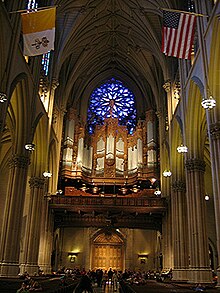Kilgen was a prominent American builder of organs which was in business from the mid-19th to the mid-20th century.
History

The Kilgen family
The Kilgen family's history of organ making supposedly dates to the 17th century, when Sebastian Kilgen, a French Huguenot, fled France and took refuge in a German monastery near Durlach. There he learned organ building from the monks, and built his first organ in 1640. Succeeding generations of Kilgens remained in Durlach and carried on organ building as a family trade.
George Kilgen and Son
George Kilgen was born in Merchingen, Germany in 1821 and apprenticed to the organ builder Louis Voit in Durlach. In 1840, he emigrated to the United States for political reasons and was employed with the Jardine organ company in New York City. He founded his own company there in 1851, and in 1873 relocated to St. Louis, where his company became one of the principal suppliers of church organs to the Midwestern United States.
George Kilgen's son Charles (1859-1932) was made partner in 1885, and the business was renamed George Kilgen and Son. By the turn of the century, Kilgen and Son had grown to be the largest and most well-known organ company in St. Louis. George Kilgen died in 1902, and Charles Kilgen took over the company and headed it during its most productive years. In 1909, Charles Kilgen purchased the Pfeffer Organ Co. and added it to the company's assets. An organ manufactured and installed in 1916 By Geo. Kilgen and son was installed at St. Stephens Episcopal Church in Douglas Arizona. It is a tubular-pneumatic organ and is still in use to this day.
The Kilgen Church Organ Company
George Kilgen had another son named Henry C. Kilgen (1851-1918). The March 3, 1894 edition of Music Trade Review identified that Charles O. Kilgen, Henry Kilgen and George J. Kilgen organized the Kilgen Church Organ Company in Chicago, Illinois, with capital of $3,700. Up until this time, it appears Henry Kilgen had been operating independently, having established his own firm in St. Louis, Missouri in the early 1870s. Examples of his work can be found in Saint Augustine's Cultural Center (formerly Saint Augustine's Catholic Church) in Austin, Nevada and St. Patrick's Catholic Church (Toledo, Ohio). Henry Kilgen died on July 29, 1918. His death certificate identified him as employed at the time by Kilgen and Son of St. Louis, Missouri.
Kilgen Associates/Kilgen Organ Company
Following Charles Kilgen's death, disagreements among his four sons led to the dissolution of the Kilgen and Son firm in 1939. Charles' sons George, Charles, and Alfred Kilgen formed Kilgen Associates, which went bankrupt in 1943. His other son, Eugene, formed the Kilgen Organ Company in St. Louis, with Max Hess as his vice-president and chief engineer. In 1944 it consolidated all of its operations (which had been spread across multiple buildings) into a single new factory building on West Florissant Avenue. At the time it was engaged in producing aircraft components for the war effort. The Kilgen Organ Company built some notable organs prior to closing its doors in 1960 due to financial difficulties and labor disputes.
Organs
During the company's early years, Kilgen primarily built and installed tracker action pipe organs for small churches in the Midwest. By 1924, over four thousand Kilgen organs had been installed, many of which remain in use today. Some large Kilgen organs were built during this period as well, including the one in the Cathedral of San Fernando in San Antonio, Texas and that installed in recent years in the chapel of Ste. Anne de Detroit Catholic Church. Later, the company produced greater numbers of large organs, including the chancel and grand gallery organs at St. Patrick's Cathedral, New York and over 190 theatre organs.
References
- ^ Ochse, Orpha Caroline (1988). The History of the Organ in the United States. Indiana University Press. pp. 167. ISBN 0-253-20495-X. Retrieved December 27, 2009.
kilgen.
- ^ Kassel, Richard (2006). The organ: an encyclopedia. Routledge. p. 289. ISBN 0-415-94174-1. Retrieved December 27, 2009.
- ^ Ochse, Orpha Caroline (1988). The History of the Organ in the United States. Indiana University Press. pp. 198–9. ISBN 0-253-20495-X. Retrieved December 27, 2009.
kilgen.
- Ronald Rickard organist at St. Stephens Episcopal Church
- Chat, Changes, Casualties (Cite Guide) Archived 2011-07-14 at the Wayback Machine. Music Trade Review. Published March 3, 1894. Retrieved on 2009-12-30.
- "USA Pipe Organ Database". Organ Historical Society. 2005. Archived from the original on 9 April 2010. Retrieved 30 December 2009.
- "Church pipe organs vary in size, pitch". Toledo Blade. April 3, 1993. Retrieved December 30, 2009.
- Owen, Barbara. "Kilgen". Oxford Music Online. Retrieved 18 December 2009.
- ^ "Kilgen Company Occupies Large New St. Louis Plant" (PDF). The Diapason. 35 (9): 1. August 1, 1944.
- Schmitt, Elizabeth Towne. (2000). George Kilgen: The New York years. The Tracker Journal of the Organ Historical Society,44(3),26-31.
- Video of the Kilgen organ at Holy Cross Lutheran Church, Minneapolis, MN
- Article on the aspect of Kilgen theater organ building. Information for this article was gathered by Dale Wood from various sources, including an article by Charles Crook and B. A. Corsini in the Spring 1960 issue of Theatre Organ
- Flash player slide show of the Kilgen console and East and West chambers at the St. Joseph and St. Patrick Parish Church in Escanaba, Michigan. Photographs were taken by John Ignatowski, Director of Sacred Music at the St. Joseph and St. Patrick Parish.
- Web pages dedicated to the restoratio9n of the eighty-year-old Kilgen Organ. Includes booklet on the building of the organ and the collaboration with the organist at St. Patrick's Cathedral in New York City.
